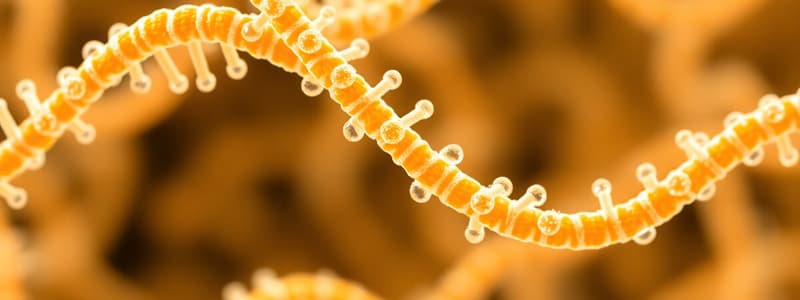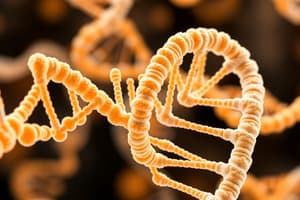Podcast
Questions and Answers
What are the two types of nucleic acids?
What are the two types of nucleic acids?
- DNA and RNA (correct)
- DNA and cDNA
- DNA and tRNA
- RNA and mRNA
Which component of a nucleotide differs between DNA and RNA?
Which component of a nucleotide differs between DNA and RNA?
- Pentose sugar (correct)
- Nitrogens
- Phosphate group
- Nitrogenous base
What do nucleotides join together to form?
What do nucleotides join together to form?
- Lipids
- Polypeptides
- Proteins
- Nucleic acids (correct)
What is released when two nucleotides join together?
What is released when two nucleotides join together?
Which nitrogenous bases are found in nucleotides?
Which nitrogenous bases are found in nucleotides?
Which sugar is present in RNA nucleotides?
Which sugar is present in RNA nucleotides?
What type of chemical reaction is transesterification?
What type of chemical reaction is transesterification?
What is the role of pyrophosphate in the formation of nucleic acids?
What is the role of pyrophosphate in the formation of nucleic acids?
What characterizes an ester bond?
What characterizes an ester bond?
What is the role of oligonucleotides in molecular biology?
What is the role of oligonucleotides in molecular biology?
Which base pairing occurs in RNA?
Which base pairing occurs in RNA?
What is typical of polynucleotides?
What is typical of polynucleotides?
How are base pairs in DNA primarily held together?
How are base pairs in DNA primarily held together?
Which nucleotide is not found in RNA?
Which nucleotide is not found in RNA?
What happens during complementary base pairing in RNA?
What happens during complementary base pairing in RNA?
Why is the attraction between base pairs in nucleic acids not as strong as covalent bonds?
Why is the attraction between base pairs in nucleic acids not as strong as covalent bonds?
What pairs with adenine in RNA?
What pairs with adenine in RNA?
What is the process called when DNA is copied into RNA?
What is the process called when DNA is copied into RNA?
What describes the complete set of DNA in a living organism?
What describes the complete set of DNA in a living organism?
Which of the following processes uses an existing strand as a template?
Which of the following processes uses an existing strand as a template?
How many pairs of chromosomes does each somatic cell in the human body normally have?
How many pairs of chromosomes does each somatic cell in the human body normally have?
What are the sequences of DNA that are transcribed into RNA called?
What are the sequences of DNA that are transcribed into RNA called?
What is the overall process of transcription and translation referred to as?
What is the overall process of transcription and translation referred to as?
What structural feature is characteristic of DNA?
What structural feature is characteristic of DNA?
Flashcards
Nucleic acids
Nucleic acids
Polymers that store, transmit, and use genetic information.
Nucleotide
Nucleotide
The monomer of nucleic acids.
Nitrogenous base
Nitrogenous base
Part of a nucleotide, either a pyrimidine or purine.
Pyrimidine
Pyrimidine
Signup and view all the flashcards
Purine
Purine
Signup and view all the flashcards
Phosphodiester linkage
Phosphodiester linkage
Signup and view all the flashcards
Nucleoside
Nucleoside
Signup and view all the flashcards
Transesterification
Transesterification
Signup and view all the flashcards
Ester bond
Ester bond
Signup and view all the flashcards
Oligonucleotides
Oligonucleotides
Signup and view all the flashcards
Polynucleotides
Polynucleotides
Signup and view all the flashcards
Base pairing in DNA and RNA
Base pairing in DNA and RNA
Signup and view all the flashcards
Hydrogen bonding in nucleic acids
Hydrogen bonding in nucleic acids
Signup and view all the flashcards
RNA base pairing
RNA base pairing
Signup and view all the flashcards
Why is RNA typically single-stranded?
Why is RNA typically single-stranded?
Signup and view all the flashcards
What makes DNA and RNA different?
What makes DNA and RNA different?
Signup and view all the flashcards
DNA Replication
DNA Replication
Signup and view all the flashcards
Transcription
Transcription
Signup and view all the flashcards
Translation
Translation
Signup and view all the flashcards
Gene Expression
Gene Expression
Signup and view all the flashcards
Genome
Genome
Signup and view all the flashcards
Gene
Gene
Signup and view all the flashcards
Somatic Cell
Somatic Cell
Signup and view all the flashcards
X Chromosome
X Chromosome
Signup and view all the flashcards
Study Notes
Nucleic Acids
- Nucleic acids are polymers for storing, transmitting, and using genetic information
- Two main types: DNA (deoxyribonucleic acid) and RNA (ribonucleic acid)
- Monomers are nucleotides
Nucleotide Components
- Nitrogen-containing base (A nitrogenous base)
- Pyrimidine: six-membered single-ring structure
- Cytosine (C)
- Thymine (T)
- Uracil (U)
- Purine: fused double-ring structure
- Adenine (A)
- Guanine (G)
- Pyrimidine: six-membered single-ring structure
- Pentose sugar (five-carbon sugar)
- Deoxyribose (in DNA)
- Ribose (in RNA)
- One to three phosphate groups
Nucleosides & Nucleotides
- Nucleosides: pentose sugar + nitrogenous base (no phosphate)
- Nucleotide monophosphates: nucleosides with one phosphate group.
Phosphodiester Linkages
- Nucleotides join through phosphodiester linkages between the 5' and 3' carbons
- Release pyrophosphate (2 phosphate groups) provides energy for the reaction.
Oligonucleotides and Polynucleotides
- Oligonucleotides: short RNA molecules (about 20 nucleotides), function in DNA replication, gene expression
- Polynucleotides: longer strands of RNA and DNA, DNA contains hundreds of millions of nucleotides; the largest polymers in living organisms
Base Pairing
- Complementary base pairing occurs in DNA and RNA
- DNA: A with T, C with G; RNA: A with U, C with G
- Base pairing held together primarily by hydrogen bonds.
RNA Structure
- Typically single-stranded
- Can form base pairings within the same molecule or with DNA
DNA Structure
- Double-stranded helix formed by two polynucleotide strands
- Bases pair to hold strands together, (hydrogen bonds)
- Key differences among DNA molecules are their different nucleotide bases
DNA Functions
- DNA carries information, expressed through RNA in two ways:
- Replication: Identical copies are made.
- Transcription: DNA sequence is copied into RNA.
- Translation: RNA sequence determines amino acid sequence in proteins, followed by gene expression.
Genes
- Segments of DNA transcribed into RNA
- The complete set of DNA in an organism is called its genome.
- Not all DNA in a genome is used all the time.
Chromosomes
- Structures containing genes.
- Somatic cells normally have 23 pairs of chromosomes. (human)
Studying That Suits You
Use AI to generate personalized quizzes and flashcards to suit your learning preferences.



